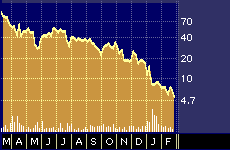
Vignette CEO Counters Critics
Vignette CEO Counters Critics
By Hal Plotkin
CNBC.com Silicon Valley Correspondent
Mar 6, 2001 10:47 AM
Vignette’s stock got hammered again late last week when analysts at Credit Suisse First Boston and Morgan Stanley joined several others who had downgraded the stock a few weeks earlier.
The new downgrades were the latest setback for a stock that is now trading about 95 percent off its 52-week high. Some of the analysts who downgraded the stock claim Vignette has lost sight of its original focus — helping online firms manage the content on their sites — in favor of the more nebulous and more difficult customer-relationship market. There have also been concerns expressed recently about the company’s ability to close sales in an increasingly tough climate.
CNBC.com: A Sad Vignette
CNBC.com explores these issues in an exclusive interview with Vignette chairman, president and CEO Greg Peters.
CNBC.com: There has been some confusion among analysts lately about whether Vignette is a content-management firm, a business-to-business firm, or an electronic customer relationship management firm. Which is it and why?
Greg Peters:

One-year performance of VIGN.
We are a leading provider of customer-driven Internet applications. We’re focused around content management, which is the core of what we do. We have more customers in that space and more leading customers in that space than any other company. But we’re very focused on sell-side applications because that is what our customers are focused on. Content management is a broad category. Our focus is really around applications and what business processes need to be automated in the sell-side applications to drive real value for our customers. Content management, a category we essentially created, is key to that.
CNBC.com: Vignette’s average deal size went from $405,000 to $540,000 over the last quarter. But some observers have said you would be better off not pursuing big-ticket deals in favor of a strategy that lets larger numbers of customers take on more “bite-sized” initial engagements. How do you respond to that criticism?
Greg Peters: Customers will only pay for what they get value for. We now have more products to offer and costs go up, but as they do, value goes up, too. There are ways for customers to get into our products for as little as $100,000 to $150,000. It really depends on how many applications they want to deploy. The price is tied to the value created. But if you look at the names of our customers, they are the leaders in high tech, transportation, financial services and new media. I’m not ashamed that our customers are willing to pay for value.
CNBC.com: The number of deals that fell-through at the end of the last quarter has led to some speculation about weakness in Vignette’s sales force and worries about the company’s ability to close sales. How do you respond to those concerns?
Greg Peters: We focus on what we can control. We have a strong sales force that has executed better over the past two years than any other software firm ever. When we went public in February 1999 we were expected to do $37 million in revenue for 1999 and $62 million in 2000. We just did $367 million [in fiscal 2000]. So we’ve built a sales force that can execute. You can tell a leading company by the company it keeps. We’re working with companies such as BEA Systems {BEAS}, Ariba {ARBA}, Dell {DELL}, IBM {IBM}, Sun {SUNW} and Microsoft {MSFT}, worldwide leading companies driving strategic value in the marketplace together. We clearly believe in the market opportunity ahead and are positioned better than anyone in the space. Our numbers bear that out. So whatever short-term issues exist surrounding the economy will work to our benefit coming out of it.
CNBC.com: The have been a number of conspicuous failures among first generation dot com businesses, including among some of your customers. Do you think these experiences will make it harder for you to close sales in the near future?
Greg Peters: There has been a lot learned over the last couple of years. That learning is extremely exciting in terms of the way companies look at the Internet. The Internet is not going to be put back in the bottle. Companies view it as a means to extend their channels with customers. Our revenues are now being driven by the traditional brick-and-mortar firms, the Fortune 1000 customers who accounted for 96 percent of our business in the last quarter. As dot-com revenue has gone down, we’ve seen the brick-and-mortar firms invest more.
CNBC.com: Vignette’s stock has been downgraded by a number of analysts in recent weeks, some citing company-specific factors and others worried about the impact of overall weakness in the economy on software firms such as Vignette. What can you say to investors in response to those downgrades?
Greg Peters: I don’t think there is any question that the long-term opportunity for Vignette is extremely large. What we can do is what we are doing, which is to focus on our customers. If you look at the history of enterprise software segments, typically there are companies that focus on and get the early customers. Those are ultimately the companies that succeed in that space. We sit here with more customers, more leading customers, than anyone in that space. We’re in the strongest position we have ever been in. We’ve got almost half a billion in cash. No one else has that. In a period of uncertainty, we will continue to lead this market, and when the economy works itself out, we’ll be in a very strong position.


